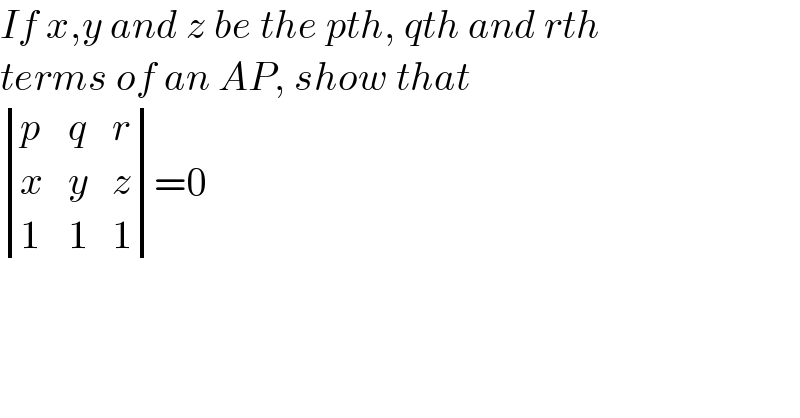
Question Number 175838 by Rasheed.Sindhi last updated on 08/Sep/22

$${If}\:{x},{y}\:{and}\:{z}\:{be}\:{the}\:{pth},\:{qth}\:{and}\:{rth} \\ $$$${terms}\:{of}\:{an}\:{AP},\:{show}\:{that} \\ $$$$\begin{vmatrix}{{p}}&{{q}}&{{r}}\\{{x}}&{{y}}&{{z}}\\{\mathrm{1}}&{\mathrm{1}}&{\mathrm{1}}\end{vmatrix}=\mathrm{0} \\ $$
Answered by Rasheed.Sindhi last updated on 08/Sep/22
![determinant ((p,q,r),(x,y,z),(1,1,1))=0 determinant ((p,q,r),((a+(p−1)d),(a+(q−1)d),(a+(q−1)d)),(1,1,1)) = determinant ((p,q,r),((a−d+pd),(a−d+qd),(a−d+qd)),(1,1,1)) = determinant ((p,q,r),((a−d),(a−d),(a−d)),(1,1,1))[R2−R1∙d] =(a−d) determinant ((p,q,r),(1,1,1),(1,1,1))=(a−d)∙0=0 [Two rows are identical] Proved](Q175872.png)
$$\begin{vmatrix}{{p}}&{{q}}&{{r}}\\{{x}}&{{y}}&{{z}}\\{\mathrm{1}}&{\mathrm{1}}&{\mathrm{1}}\end{vmatrix}=\mathrm{0} \\ $$$$\begin{vmatrix}{{p}}&{{q}}&{{r}}\\{{a}+\left({p}−\mathrm{1}\right){d}}&{{a}+\left({q}−\mathrm{1}\right){d}}&{{a}+\left({q}−\mathrm{1}\right){d}}\\{\mathrm{1}}&{\mathrm{1}}&{\mathrm{1}}\end{vmatrix} \\ $$$$=\begin{vmatrix}{{p}}&{{q}}&{{r}}\\{{a}−{d}+{pd}}&{{a}−{d}+{qd}}&{{a}−{d}+{qd}}\\{\mathrm{1}}&{\mathrm{1}}&{\mathrm{1}}\end{vmatrix} \\ $$$$=\begin{vmatrix}{{p}}&{{q}}&{{r}}\\{{a}−{d}}&{{a}−{d}}&{{a}−{d}}\\{\mathrm{1}}&{\mathrm{1}}&{\mathrm{1}}\end{vmatrix}\left[\mathrm{R2}−\mathrm{R1}\centerdot\mathrm{d}\right] \\ $$$$=\left({a}−{d}\right)\begin{vmatrix}{{p}}&{{q}}&{{r}}\\{\mathrm{1}}&{\mathrm{1}}&{\mathrm{1}}\\{\mathrm{1}}&{\mathrm{1}}&{\mathrm{1}}\end{vmatrix}=\left({a}−{d}\right)\centerdot\mathrm{0}=\mathrm{0} \\ $$$$\left[\mathcal{T}{wo}\:{rows}\:{are}\:{identical}\right] \\ $$$${Proved} \\ $$
Answered by som(math1967) last updated on 08/Sep/22
![determinant ((p,q,r),((a+pd−d),(a+qd−d),(a+rd−d)),(1,1,1)) C_1 ^l →C_1 −C_2 ,C_2 ^l →C_2 −C_3 determinant (((p−q),(q−r),r),(((p−q)d),((q−r)d),(a+rd−d)),(0,0,1)) (p−q)(q−r) determinant ((1,1,r),(d,d,(a+rd−d)),(0,0,1)) =(p−q)(q−r)×0 [C_1 ,C_2 identical] =0](Q175873.png)
$$\begin{vmatrix}{{p}}&{{q}}&{{r}}\\{{a}+{pd}−{d}}&{{a}+{qd}−{d}}&{{a}+{rd}−{d}}\\{\mathrm{1}}&{\mathrm{1}}&{\mathrm{1}}\end{vmatrix} \\ $$$${C}_{\mathrm{1}} ^{{l}} \rightarrow{C}_{\mathrm{1}} −{C}_{\mathrm{2}} \:,{C}_{\mathrm{2}} ^{{l}} \rightarrow{C}_{\mathrm{2}} −{C}_{\mathrm{3}} \\ $$$$\begin{vmatrix}{{p}−{q}}&{{q}−{r}}&{{r}}\\{\left({p}−{q}\right){d}}&{\left({q}−{r}\right){d}}&{{a}+{rd}−{d}}\\{\mathrm{0}}&{\mathrm{0}}&{\mathrm{1}}\end{vmatrix} \\ $$$$\left({p}−{q}\right)\left({q}−{r}\right)\begin{vmatrix}{\mathrm{1}}&{\mathrm{1}}&{{r}}\\{{d}}&{{d}}&{{a}+{rd}−{d}}\\{\mathrm{0}}&{\mathrm{0}}&{\mathrm{1}}\end{vmatrix} \\ $$$$=\left({p}−{q}\right)\left({q}−{r}\right)×\mathrm{0}\:\left[{C}_{\mathrm{1}} ,{C}_{\mathrm{2}} \:{identical}\right] \\ $$$$=\mathrm{0} \\ $$
Commented by Rasheed.Sindhi last updated on 08/Sep/22

$${Good}\:{sir},\:{thank}\:{you}! \\ $$
